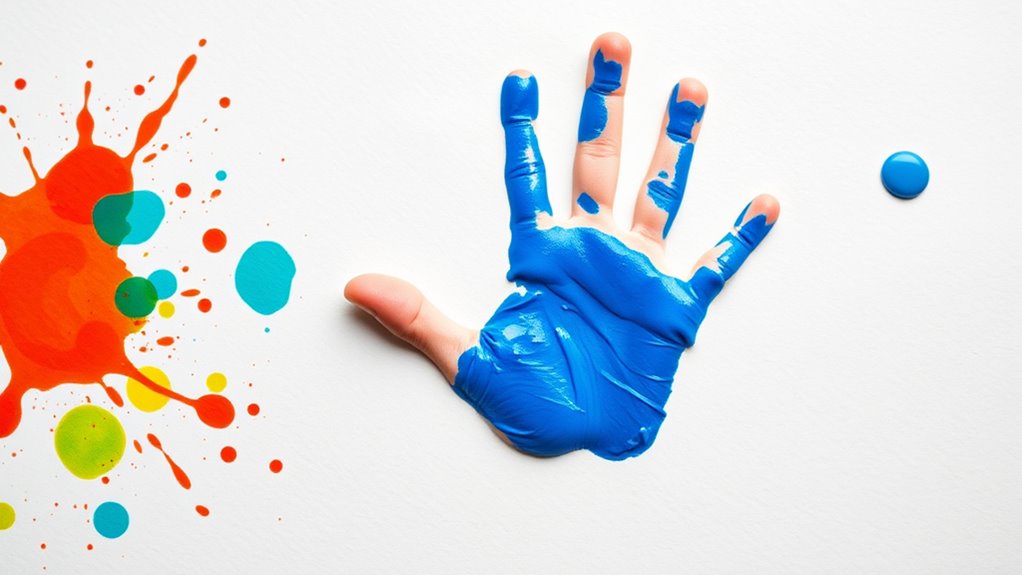Handprint art is a fun craft that boosts fine motor skills by encouraging kids to grasp, press, and manipulate paint with purpose. As you guide them to turn handprints into animals, characters, or abstract designs, they improve hand-eye coordination and finger dexterity. Using safe, washable paints makes cleanup simple, while the creative process sparks imagination. Keep exploring these techniques to make your projects more engaging and educational—there’s much more to discover beyond the basics.
Key Takeaways
- Handprint art sparks creativity while helping children develop fine motor skills through grasping and pressing paint.
- Transforming handprints into animals or characters encourages imaginative thinking and detailed craftsmanship.
- Using non-toxic, washable paints ensures a safe and sensory-rich experience for children.
- The activity enhances hand-eye coordination and finger dexterity with simple modifications and added details.
- Proper preparation and supervision make handprint art a fun, educational craft promoting self-expression and skill development.

Have you ever tried turning a simple handprint into a creative work of art? It’s a fun activity that not only sparks your imagination but also helps develop fine motor skills in children. When you immerse yourself in handprint art, you’re exploring a world of creative techniques that allow you to transform a basic outline into detailed pictures, animals, or even abstract designs. To make the process enjoyable and safe, it’s essential to keep safety tips in mind, especially if kids are involved. Using non-toxic paints and ensuring proper supervision can prevent any mishaps. Covering surfaces with newspaper or a plastic tablecloth keeps cleanup easy, and wearing smocks or old clothes protects clothing from accidental paint splatters.
Once you gather your supplies—non-toxic washable paints, brushes, paper or canvas—you can start experimenting with different creative techniques. For example, you might turn a handprint into a butterfly by adding antennae and wings, or create a tree by painting a trunk and then adding leaves around the fingers. Using contrasting colors or blending paints can add depth and vibrancy to your artwork. Kids love seeing their handprints turn into animals or characters, and you might encourage them to think outside the box, transforming each print into something unique. This activity is perfect for sparking creativity and self-expression, especially when you let imaginations run wild with ideas.
Transform handprints into animals or trees with creative touches and vibrant colors.
As you work, remember to pay close attention to safety tips, especially when handling paints and brushes. Make sure all paints are labeled as non-toxic and safe for children. Keep small items out of reach to prevent choking hazards, and always supervise young children during the activity. It’s also a good idea to remind everyone to wash their hands thoroughly after completing their handprint art to remove any residual paint. If you’re working with paint brushes, ensure they are clean and in good condition to avoid any accidental injuries from broken bristles or rough edges.
Handprint art isn’t just about creating a pretty picture; it’s a wonderful way to strengthen fine motor skills. The act of making a handprint involves grasping brushes or even just pressing the hand down onto paper, which helps improve hand-eye coordination and finger dexterity. As children practice these movements, they gain better control over their small muscles, which benefits writing and other daily activities. Plus, this activity encourages sensory exploration—feeling the different textures of paint and paper—making it both educational and engaging. Whether you’re crafting with kids or creating your own art, handprint projects offer a perfect blend of fun, creativity, and skill-building.
Frequently Asked Questions
What Are the Best Non-Toxic Paints for Handprint Art?
When choosing non-toxic paints for handprint art, you want options that are safe and easy to clean. Washable paints are your best bet because they’re gentle on skin and come off easily with water. Look for labels that specify non-toxic and washable, ensuring your child’s safety while making fun memories. These paints are perfect for little hands and help develop fine motor skills safely and enjoyably.
How Can I Preserve My Child’s Handprint Art Long-Term?
You want to keep those precious creations alive, and it’s easier than you think. To preserve your child’s handprint art long-term, consider framing ideas that protect and showcase it. Use clear, acid-free storage solutions to prevent deterioration. Keep it away from direct sunlight and humidity, which can fade or damage the piece. With a little care, your child’s masterpiece will stand the test of time, a cherished reminder of their growth.
Are There Any Safety Tips for Making Handprint Art With Toddlers?
When making handprint art with toddlers, safety is key. Always supervise your child closely to prevent choking or messes. Use non-toxic, washable paints to guarantee paint safety, and test them on a small skin patch first. Keep the workspace clean and dry, and have wipes or a damp cloth ready for quick cleanup. Your careful supervision and choosing safe materials make the craft fun and safe for your little one.
What Are Creative Ideas for Themed Handprint Art Projects?
Imagine transforming those tiny handprints into exciting themed masterpieces! You can craft seasonal motifs like pumpkins, snowflakes, or flowers, or explore animal themes such as elephants, butterflies, or cats. These ideas spark creativity and make art fun for your toddler. With a little imagination, each handprint becomes a unique story, blending art and play. Ready to create memorable keepsakes that celebrate every season and animal adventure?
How Can Handprint Art Be Adapted for Children With Special Needs?
To adapt handprint art for children with special needs, you can incorporate sensory adaptations and use alternative tools. For example, provide textured paints or sponges for sensory input, and offer thicker brushes or stamps to make handprints easier to create. You might also allow children to use their fists or other body parts if handprints are challenging, ensuring the activity remains engaging and accessible while promoting fine motor development.
Conclusion
Now that you’ve created your handprint art, you’ve revealed the secret to turning tiny handprints into masterpieces that could rival the Mona Lisa! Not only did you craft a fun, memorable keepsake, but you also supercharged your child’s fine motor skills—making their tiny fingers capable of more than just grabbing snacks. So next time you’re looking for a super fun, skill-building activity, remember, your hands hold the power to create magic—and maybe even the next great artist!










